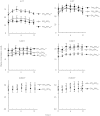Metabolism of citalopram enantiomers in CYP2C19/CYP2D6 phenotyped panels of healthy Swedes
- PMID: 12968986
- PMCID: PMC1884377
- DOI: 10.1046/j.1365-2125.2003.01874.x
Metabolism of citalopram enantiomers in CYP2C19/CYP2D6 phenotyped panels of healthy Swedes
Abstract
Aims: To investigate pharmacokinetics of the enantiomers of citalopram (CT) and its metabolites desmethylcitalopram (DCT) and didesmethylcitalopram (DDCT) in Swedish healthy volunteers in relation to CYP2C19 and CYP2D6 geno- and phenotypes.
Methods: Racemic CT was given for seven days to panels with different genotypes and the following mephenytoin (Me) and debrisoquine (De) hydroxylation phenotypes: EMDe/EMMe, PMDe/EMMe, EMDe/PMMe (n = 6 in all groups), and one PMDe/PMMe subject. Blood sampling was carried out during day 7, and all urine was collected for 12 h after the last dose of CT.
Results: The AUC of S-CT was significantly higher in the EMDe/PMMe panel compared to the EMDe/EMMe and PMDe/EMMe panels (P < 0.05), whereas the AUC of R-CT did not differ between the panels. Similar differences, although they did not reach statistical significance, were noted for S-DCT and R-DCT. The enantiomers of DDCT were not quantifiable in PMDe, and there was no difference in DDCT enantiomer concentrations between the other two panels. A PMDe/PMMe subject stopped taking CT after five days due to severe adverse effects. Based on two time points, this subject had a very long CT half-life of 95 h. The value of 1.0 for the S/R ratio of the CT trough in this subject was similar to the mean S/R CT trough ratio of the EMDe/PMMe panel, but higher than the S/R CT ratio of the EMDe/EMMe panel (0.56; 95% CI 0.49-0.63) and the PMDe/EMMe panel (0.44; 95% CI 0.31-0.57). Thus the latter two phenotypes eliminated S-CT more rapidly via CYP2C19. An adverse effect described as an 'alcohol hangover' feeling was reported by one subject from each of the three panels. These individuals had the highest concentrations of both CT enantiomers.
Conclusions: The AUC of S-, but not R-(CT) was found to be significantly higher in PM of mephenytoin compared to EMs, PMs may need a lower dosage of CT.
Figures


References
-
- Hyttel J. Neurochemical characterization of a new potent and selective serotonin uptake inhibitor: Lu 10–171. Psychopharmacology (Berl) 1977;51:225–233. - PubMed
-
- Milne RJ, Goa KL. Citalopram. A review of its pharmacodynamic and pharmacokinetic properties, and therapeutic potential in depressive illness. Drugs. 1991;41:450–477. - PubMed
-
- Humble M, Wistedt B. Serotonin, panic disorder and agoraphobia: short-term and long-term efficacy of citalopram in panic disorders. Int Clin Psychopharmacol. 1992;6(Suppl 5):21–39. - PubMed
-
- Masand PS, Gupta S. Selective serotonin-reuptake inhibitors: an update. Harv Rev Psychiatry. 1999;7:69–84. - PubMed
-
- Naranjo CA, Poulos CX, Bremner KE, Lanctot KL. Citalopram decreases desirability, liking, and consumption of alcohol in alcohol-dependent drinkers. Clin Pharmacol Ther. 1992;51:729–739. - PubMed
Publication types
MeSH terms
Substances
LinkOut - more resources
Full Text Sources
Medical
Molecular Biology Databases
Research Materials

